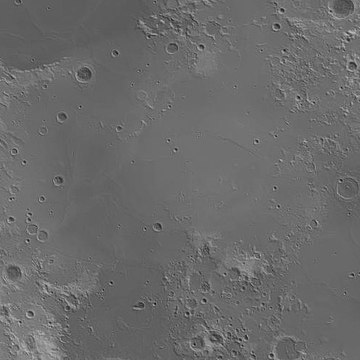
Back Mare Tranquillitatis Afrikaans بحر السكون Arabic Мора Спакою Byelorussian Море на спокойствието Bulgarian Mare Tranquillitatis Catalan Mare Tranquillitatis Czech Stilhedens Hav Danish Mare Tranquillitatis German Mare Tranquillitatis Spanish Vaikuse meri Estonian
 The Sea of Tranquility of the Moon | |
| Coordinates | 8°30′N 31°24′E / 8.5°N 31.4°E |
|---|---|
| Diameter | 876 km (544 mi)[1][2] |
| Eponym | Sea of Tranquility |
Mare Tranquillitatis /træŋˌkwɪlɪˈteɪtɪs/ (Latin for Sea of Tranquillity or Sea of Tranquility)[a] is a lunar mare that sits within the Tranquillitatis basin on the Moon. It contains Tranquility Base, the first location on another celestial body to be visited by humans.
The mare material within the basin consists of basalt formed in the intermediate to young age group of the Upper Imbrian epoch. The surrounding mountains are thought to be of the Lower Imbrian epoch, but the actual basin is probably Pre-Nectarian. The basin has irregular margins and lacks a defined multiple-ringed structure. The irregular topography in and near this basin results from the intersection of the Tranquillitatis, Nectaris, Crisium, Fecunditatis, and Serenitatis basins with two throughgoing rings of the Procellarum basin. Palus Somni, on the northeastern rim of the mare, is filled with the basalt that spilled over from Tranquillitatis.
This mare has a slight bluish tint relative to the rest of the Moon and stands out quite well when color is processed and extracted from multiple photographs. The color is likely due to higher metal content in the basaltic soil or rocks.[3]
Unlike many other maria, there is no mass concentration (mascon), or gravitational high, in the center of Mare Tranquillitatis. Mascons were identified in the center of other maria (such as Serenitatis or Imbrium) from Doppler tracking of the five Lunar Orbiter spacecraft in 1968.[4] The gravity field was mapped at higher resolution with later orbiters such as Lunar Prospector and GRAIL, which unveiled an irregular pattern.
-
Topographic map
-
Gravity map based on GRAIL

- ^ "Mare Tranquillitatis". Gazetteer of Planetary Nomenclature. USGS Astrogeology Research Program.
- ^ "Mare Tranquillitatis". NASA. Archived from the original on 2008-10-13.
- ^ Filipe Alves (July 2005). "Capturing the Colors of the Moon" (PDF). Sky and Telescope. pp. 120–122. Archived from the original (PDF) on 2014-10-20. Retrieved May 29, 2019.
- ^ P. M. Muller, W. L. Sjogren (1968). "Mascons: Lunar Mass Concentrations". Science. 161 (3842): 680–684. Bibcode:1968Sci...161..680M. doi:10.1126/science.161.3842.680. PMID 17801458. S2CID 40110502.
Cite error: There are <ref group=lower-alpha> tags or {{efn}} templates on this page, but the references will not show without a {{reflist|group=lower-alpha}} template or {{notelist}} template (see the help page).

